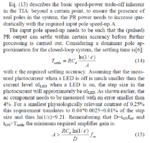JamesGon
Junior Member level 1
Hi
I am trying to estimate the shot-noise from ambient light sources (sunlight and Fluorescent lamps).
I expect to shield my photodiode as good as possible - so no direct light is hitting it.
Second, what is the relationship between photodiode area size and noise from ambient light - is it proportional like: Id(shot-current) = Area*responsivity*irradiance.
Thank you.
I am trying to estimate the shot-noise from ambient light sources (sunlight and Fluorescent lamps).
I expect to shield my photodiode as good as possible - so no direct light is hitting it.
Second, what is the relationship between photodiode area size and noise from ambient light - is it proportional like: Id(shot-current) = Area*responsivity*irradiance.
Thank you.

